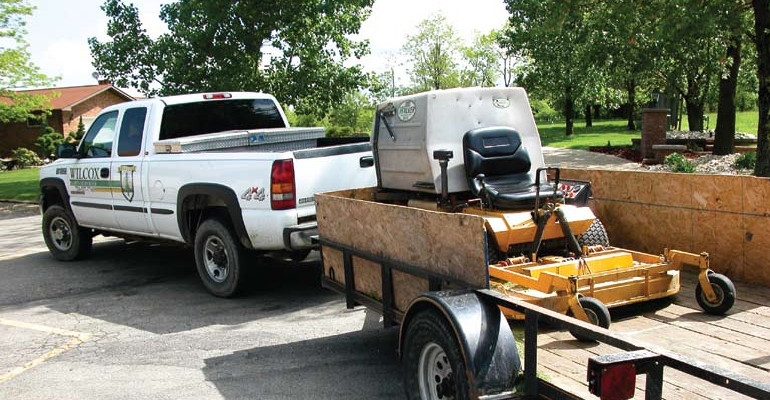As a Walker Mower owner, you understand the important difference between value and price. Walker Mowers are not the least expensive mowers on the market. Contractors buy them because they provide superior value. In other words, Walker Mower operators understand the old adage that “you get what you pay for.” The challenge for many mowing contractors is to get their customers to understand the same thing.
Getting the full and fair price for your service seems to be getting more difficult as days go by. The collapse of the housing market has forced many contractors to forego the design/build business in favor of mowing and maintaining landscapes. Out-of-work factory employees are picking up the income slack by buying a mower and trailer. In addition to more competition, there’s already a disturbing trend in the commercial mowing market to label mowing as a commodity service.

More competition and the failure to differentiate one service from another has put incredible pressure on price. Competing on price alone, however, is a one-way street. How low will you go to beat your competitor’s price? How much are you willing to lose in profit margin to win that job? And how long can you reasonably expect to stay in business when the cost of doing business is going up while your price is going down?
There are two ways to compete. You can compete on value, or you can compete on price. Unless your business model is set up to be the market’s low-cost service provider, competing on price alone can be devastating to the bottom line and your business. Just how devastating is as simple as doing the math.
If you’re operating on a healthy, 30-percent margin and offer a 10-percent discount to customers, you will have to generate another 50 percent in sales to make up the difference in lost profit. Giving that same discount while operating on a 20-percent margin will require you to sell twice as much business to get the return you need. Larger discounts are even that much more devastating to the bottom line
Discounting can have other negative consequences, as well. Discounting can dilute your brand, and customers will begin to wonder just how much your service is worth.
“How can I sell in today’s supercompetitive marketplace without cutting my prices?” you ask. The answer is that you first have to separate yourself from the cost-cutting competition by creating value in your service offering and then selling that value to your customers.
Creating Value
Even though you offer a quality service, that doesn’t automatically mean it adds value for your customer. The first step to creating value is finding out what your customers value.
 Your homeowner customers, for example, may want a lawn service that does an impeccable job mowing, and then intercedes by overseeing other contractors or checking on their homes in their absence. Commercial customers often have a choice between contracting out mowing and maintenance services or performing them in house. The latter creates year-round overhead that can be bothersome.
Your homeowner customers, for example, may want a lawn service that does an impeccable job mowing, and then intercedes by overseeing other contractors or checking on their homes in their absence. Commercial customers often have a choice between contracting out mowing and maintenance services or performing them in house. The latter creates year-round overhead that can be bothersome.
Talk with your customers and find out what their major “landscape” concerns are, and then present a solution that offers real value for them. The solution or service will have residual values, as well. You’ll be doing the work and dealing with landscape issues, and your Walker Mower will provide a cut second to none. Being timely, easy to do business with and reliable will add a few more feathers to your value hat.
Selling Value
It doesn’t do anyone any good if you spend time and energy creating value, and then are unable to sell it. After finding out what’s important to your customers, explain your service offering and how it lines up with their value system.
No doubt, in this competitive market, some customers will challenge the price you put on your service. If you anticipate a price rejection, raise the price issue upfront and explain why your service is valuable. This is easy to do, especially if you have confidence that your service offering is superior to the competitor’s next door.
If the price complaint is coming from a current customer, chances are the catalyst for that complaint is caused by something other than price. It may be lack of performance, poor response time, failure to resolve an issue or something else. Find out what that is, fix it, and the price complaint will likely disappear.
Price rejection can be countered in several different ways. Property managers, for example, may be working with a tight budget. Your job, then, is to help them sell your valuable service to the property owner. It’s important, as well, to always remind price-sensitive customers that there are no “free lunches”—that mowing or otherwise maintaining their lawns, even if they do it, is already costing them time and money. And don’t end the conversation without driving home the point that no one ever regrets buying quality—that you always, always get what you pay for.
There’s no question that it can be difficult to persuade your customers to pay more for your service than a less expensive service, and frankly it’s very easy to draw a line through a number and write down a smaller number to match, or beat, the competitor’s price. In fact, the only reason people often sell on price is because that’s the only way they know how to sell.
To be a successful lawn maintenance contractor, you will need profitable customers who will stay with you for a long time. You can have these customers by finding out what they truly value, create that value, and then learn to sell it effectively. The truth is, all companies and the services they deliver are not created equally. It’s your job to sell customers on that point and not on price.
Some of the ideas in this article were excerpted from “Persuade Your Customers To Pay More”, a training DVD published by TrainingPoint.net.






 Site Search
Site Search



